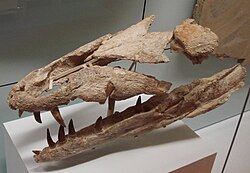Dakosaurus andiniensis
|
Dakosaurus Temporal range: Late Jurassic - Early Cretaceous, 157–137 Ma |
|
|---|---|
 |
|
| D. maximus neotype SMNS 8203, Staatliches Museum für Naturkunde Stuttgart | |
| Scientific classification | |
| Kingdom: | Animalia |
| Phylum: | Chordata |
| Class: | Reptilia |
| Suborder: | †Thalattosuchia |
| Family: | †Metriorhynchidae |
| Tribe: | †Geosaurini |
| Genus: |
†Dakosaurus von Quenstedt, 1856 |
| Type species | |
|
†Geosaurus maximus Plieninger, 1846 |
|
| Species | |
|
|
Dakosaurus is an extinct genus within the family Metriorhynchidae that lived during the Late Jurassic and Early Cretaceous. It was large, with teeth that were serrated and compressed lateromedially (flattened from side to side). The genus was established by Friedrich August von Quenstedt in 1856 for an isolated tooth named Geosaurus maximus by Plieninger. Dakosaurus was a carnivore that spent much, if not all, its life out at sea. The extent of its adaptation to a marine lifestyle means that it is most likely that it mated at sea, but since no eggs or nests have been discovered that have been referred to Dakosaurus, whether it gave birth to live young at sea like dolphins and ichthyosaurs or came ashore like turtles is not known. The name Dakosaurus means "biter lizard", and is derived from the Greek dakos ("biter") and -sauros ("lizard").
When isolated Dakosaurus teeth were first discovered in Germany, they were mistaken for belonging to the theropod dinosaur Megalosaurus. In 1856 von Quenstedt made Plieninger's Geosaurus maximus teeth a new genus with the name Dakosaurus. He explained the etymology as Greek dakos "Biss" [bite] in 1858 in German, adding "denn wenige kommen seinem furchtbaren Gebiss gleich” [for few can match its terrible set of teeth]. He gave the meaning of Greek dakos more correctly as "Beisser" [biter] in another description in 1859 in which he classified Dakosaurus as a dinosaur.
Fossil specimens referrable to Dakosaurus are known from Late Jurassic deposits from England, France, Switzerland, Germany,Poland,Russia,Argentina, and Mexico. Teeth referrable to Dakosaurus are known from Europe from the Oxfordian.
...
Wikipedia
